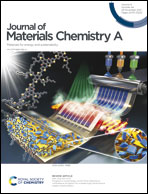Synthesis and catalytic application of nanorod-like FER-type zeolites†
Abstract
Nanosize dimensions have an important impact on zeolite properties and catalytic performance in particular. Herein, we develop a direct synthesis route to obtain a nanosized nanorod-like ferrierite (FER) zeolite with the assistance of ammonium fluoride (NH4F) and employing a conventional structure-directing agent (pyrrolidine). The resultant nanorod-like FER zeolite crystals exhibit a greatly reduced diffusion path along the c-axis. The physicochemical properties of nanorod-like FER and its conventional micronsized plate-like counterpart were analyzed by N2 adsorption–desorption, 27Al, 1H, 29Si MAS NMR, NH3-TPD, and in situ D3-acetonitrile and pyridine adsorption followed by FTIR. The nanorod-like FER zeolite possesses superior characteristics in terms of a larger external area, better accessibility to the acid sites, and a larger number of pore mouths per unit crystal surface than the micron-sized counterpart synthesized without NH4F. The improved properties provide the nanorod-like FER zeolite with high selectivity and low deactivation rates in 1-butene skeletal isomerization. The thermogravimetry analysis (TGA) of the coke amounts revealed a better capability of coke tolerance of the nanorod-like FER zeolite. The in situ ultraviolet-visible (UV/Vis) and Fourier transform infrared spectroscopy (FTIR) spectroscopy investigations of the organic intermediates formed on FER zeolite catalysts during the catalytic reaction further verified the enhanced catalytic activity and stability of the nanorod-like FER zeolite.



 Please wait while we load your content...
Please wait while we load your content...